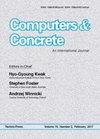Strength and strain modeling of CFRP-confined concrete cylinders using ANNs
IF 3.3
4区 工程技术
Q2 COMPUTER SCIENCE, INTERDISCIPLINARY APPLICATIONS
引用次数: 0
Abstract
Carbon fiber reinforced polymer (CFRP) has extensive use in strengthening reinforced concrete structures due to its high strength and elastic modulus, low weight, fast and easy application, and excellent durability performance. Many studies have been carried out to determine the performance of the CFRP confined concrete cylinder. Although studies about the prediction of confined compressive strength using ANN are in the literature, the insufficiency of the studies to predict the strain of confined concrete cylinder using ANN, which is the most appropriate analysis method for nonlinear and complex problems, draws attention. Therefore, to predict both strengths and also strain values, two different ANNs were created using an extensive experimental database. The strength and strain networks were evaluated with the statistical parameters of correlation coefficients (R2), root mean square error (RMSE), and mean absolute error (MAE). The estimated values were found to be close to the experimental results. Mathematical equations to predict the strength and strain values were derived using networks prepared for convenience in engineering applications. The sensitivity analysis of mathematical models was performed by considering the inputs with the highest importance factors. Considering the limit values obtained from the sensitivity analysis of the parameters, the performances of the proposed models were evaluated by using the test data determined from the experimental database. Model performances were evaluated comparatively with other analytical models most commonly used in the literature, and it was found that the closest results to experimental data were obtained from the proposed strength and strain models.基于神经网络的cfrp约束混凝土圆柱体强度与应变建模
碳纤维增强聚合物(CFRP)具有强度高、弹性模量大、重量轻、应用快捷方便、耐久性好等优点,在钢筋混凝土结构加固中有着广泛的应用。为了确定碳纤维布约束混凝土筒体的性能,进行了许多研究。虽然文献中已有利用人工神经网络预测承压抗压强度的研究,但对于非线性复杂问题最适合的分析方法——人工神经网络预测承压混凝土圆柱体应变的研究不足,引起了人们的关注。因此,为了预测强度和应变值,使用广泛的实验数据库创建了两种不同的人工神经网络。采用相关系数(R2)、均方根误差(RMSE)和平均绝对误差(MAE)等统计参数对强度和应变网络进行评价。计算结果与实验结果较为接近。利用便于工程应用的网络推导了预测强度和应变值的数学方程。通过考虑重要因子最高的输入,对数学模型进行敏感性分析。考虑参数灵敏度分析得到的极限值,利用从实验数据库中确定的试验数据对所提模型的性能进行评价。将模型性能与文献中常用的其他解析模型进行比较,发现所提出的强度和应变模型得到的结果与实验数据最接近。
本文章由计算机程序翻译,如有差异,请以英文原文为准。
求助全文
约1分钟内获得全文
求助全文
来源期刊

Computers and Concrete
工程技术-材料科学:表征与测试
CiteScore
8.60
自引率
7.30%
发文量
0
审稿时长
13.5 months
期刊介绍:
Computers and Concrete is An International Journal that focuses on the computer applications in be considered suitable for publication in the journal.
The journal covers the topics related to computational mechanics of concrete and modeling of concrete structures including
plasticity
fracture mechanics
creep
thermo-mechanics
dynamic effects
reliability and safety concepts
automated design procedures
stochastic mechanics
performance under extreme conditions.
 求助内容:
求助内容: 应助结果提醒方式:
应助结果提醒方式:


